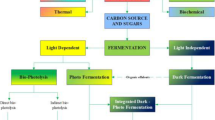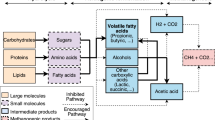Abstract
A two-stage alcoholysis was developed for improved conversion of furfural residue (FR) into levulinic acid (LA) and methyl levulinate (ML). Mixed acids including 0.01 M of H2SO4 and Al2(SO4)3 and methanol/water (50/50 v/v%) were identified as the suitable catalyst and reaction medium. The optimum alcoholysis conditions were 198 °C and 1.5 h for the 1st stage and then 163 °C and 1.3 h for the 2nd stage, and the maximum total yield of LA and ML can reach 25.64%. The reaction kinetics and possible conversion pathways for ML and LA production were proposed. On the basis, HCOOH/H2O2 pretreatment was screened for the pretreatment of FR, which increased the cellulose content of FR from 40.01 to 71.91%. The maximum total yield of LA and ML from pretreated FR was 44.96% under the optimum conditions of 195 °C and 1.9 h for the 1st stage and then 166 °C and 1.1 h for the 2nd stage, which was 16.09% higher than that of isothermal alcoholysis. The reusability tests showed that the Al2(SO4)3 was stable and can be reused at least 5 times. This study developed a new method for high-value utilization of FR and cleaner production of LA and ML.










Similar content being viewed by others
References
Tanwongwan W, Eiad-ua A, Kraithong W, Viriya-empikul N, Suttisintong K, Klamchuen A, Kasamechonchung P, Khemthong P, Faungnawakij K, Kuboon S (2019) Simultaneous activation of copper mixed metal oxide catalysts in alcohols for gamma-valerolactone production from methyl levulinate. Appl Catal A Gen 579:91–98. https://doi.org/10.1016/j.apcata.2019.04.011
Mao G, Huang N, Chen L, Wang H (2018) Research on biomass energy and environment from the past to the future: a bibliometric analysis. Sci Total Environ 635:1081–1090. https://doi.org/10.1016/j.scitotenv.2018.04.173
Cho EJ, Trinh LTP, Song Y, Lee YG, Bae HJ (2020) Bioconversion of biomass waste into high value chemicals. Bioresour Technol 298:122386
Kumar A, Shende DZ, Wasewar KL (2020) Production of levulinic acid: a promising building block material for pharmaceutical and food industry. Mater Today Proc 29:790–793. https://doi.org/10.1016/j.matpr.2020.04.749
Liang X, Fu Y, Chang J (2020) Sustainable production of methyl levulinate from biomass in ionic liquid-methanol system with biomass-based catalyst. Fuel 259:259. https://doi.org/10.1016/j.fuel.2019.116246
Thion S, Togbé C, Dagaut P, Dayma G, Serinyel Z (2019) Kinetics of oxidation of levulinic biofuels in a jet-stirred reactor: methyl levulinate. Proc Combust Inst 37:381–388. https://doi.org/10.1016/j.proci.2018.05.137
Chang C, Xu G, Zhu W, Bai J, Fang S (2015) One-pot production of a liquid biofuel candidate - ethyl levulinate from glucose and furfural residues using a combination of extremely low sulfuric acid and zeolite USY. Fuel 140:365–370. https://doi.org/10.1016/j.fuel.2014.09.102
Kalghatgi SG, Bhanage BM (2019) Green syntheses of levulinate esters using ionic liquid 1-methyl imidazolium hydrogen sulphate [MIM][HSO4] in solvent free system. J Mol Liq 281:70–80. https://doi.org/10.1016/j.molliq.2019.02.053
Garves K (1988) Acid catalyzed degradation of cellulose in alcohols. J Wood Chem Technol 8:121–134. https://doi.org/10.1080/02773818808070674
Bart HJ, Reidetschläger J, Schatka K, Lehmann A (1994) Kinetics of esterification of levulinic acid with n-butanol by homogeneous catalysis. Ind Eng Chem Res 33:21–25. https://doi.org/10.1021/ie00025a004
Zhang Y, Chen X, Lyu X, Zhao G, Zhao T, Han L, Xiao W (2019) Aluminum phosphotungstate as a promising bifunctional catalyst for biomass carbohydrate transformation to methyl levulinate under mild conditions. J Clean Prod 215:712–720. https://doi.org/10.1016/j.jclepro.2019.01.062
Heda J, Niphadkar P, Mudliar S, Bokade V (2020) Highly efficient micro-meso acidic H-USY catalyst for one step conversion of wheat straw to ethyl levulinate (biofuel additive). Microporous Mesoporous Mater 306:110474. https://doi.org/10.1016/j.micromeso.2020.110474
Zhou L, Zou H, Nan J, Wu L, Yang X, Su Y, Lu T, Xu J (2014) Conversion of carbohydrate biomass to methyl levulinate with Al2(SO4)3 as a simple, cheap and efficient catalyst. Catal Commun 50:13–16. https://doi.org/10.1016/j.catcom.2014.02.021
Tan J, Liu Q, Chen L, Wang T, Ma L, Chen G (2017) Efficient production of ethyl levulinate from cassava over Al2(SO4)3 catalyst in ethanol–water system. J Energy Chem 26:115–120. https://doi.org/10.1016/j.jechem.2016.08.004
An R, Xu G, Chang C, Bai J, Fang S (2017) Efficient one-pot synthesis of n-butyl levulinate from carbohydrates catalyzed by Fe2(SO4)3. J Energy Chem 26:556–563. https://doi.org/10.1016/j.jechem.2016.11.015
Li P, Du Z, Chang C et al (2020) Efficient catalytic conversion of waste peanut shells into liquid biofuel: an artificial intelligence approach. Energy Fuel 34:1791–1801. https://doi.org/10.1021/acs.energyfuels.9b03433
Amarasekara AS, Wiredu B (2014) Acidic ionic liquid catalyzed one-pot conversion of cellulose to ethyl levulinate and levulinic acid in ethanol-water solvent system. Bioenergy Res 7:1237–1243. https://doi.org/10.1007/s12155-014-9459-z
Huang YB, Yang T, Lin YT, Zhu YZ, Li LC, Pan H (2018) Facile and high-yield synthesis of methyl levulinate from cellulose. Green Chem 20:1323–1334. https://doi.org/10.1039/c7gc02883k
Hammer NL, Garrido RA, Starcevich J, Coe CG, Satrio JA (2015) Two-step pyrolysis process for producing high quality bio-oils. Ind Eng Chem Res 54:10629–10637. https://doi.org/10.1021/acs.iecr.5b02365
Bu L, Tang Y, Gao Y, Jian H, Jiang J (2011) Comparative characterization of milled wood lignin from furfural residues and corncob. Chem Eng J 175:176–184. https://doi.org/10.1016/j.cej.2011.09.091
Vega PLA, Villaverde JJ (2010) Delignification of Miscanthus × Giganteus by the Milox process. Bioresour Technol 101:3188–3193. https://doi.org/10.1016/j.biortech.2009.12.021
Chang C, Deng L, Xu G (2018) Efficient conversion of wheat straw into methyl levulinate catalyzed by cheap metal sulfate in a biorefinery concept. Ind Crop Prod 117:197–204. https://doi.org/10.1016/j.indcrop.2018.03.009
Hu X, Lievens C, Larcher A, Li CZ (2011) Reaction pathways of glucose during esterification: effects of reaction parameters on the formation of humin type polymers. Bioresour Technol 102:10104–10113. https://doi.org/10.1016/j.biortech.2011.08.040
Hu X, Song Y, Wu L, Gholizadeh M, Li CZ (2013) One-pot synthesis of levulinic acid/ester from C5 carbohydrates in a methanol medium. ACS Sustain Chem Eng 1:1593–1599. https://doi.org/10.1021/sc400229w
Ludot C, Estrine B, Hoffmann N, Bras JL, Marinkovic S, Muzart J (2014) Manufacture of decyl pentosides surfactants by wood hemicelluloses transglycosidation: a potential pretreatment process for wood biomass valorization. Ind Crop Prod 58:335–339. https://doi.org/10.1016/j.indcrop.2014.04.039
Chen X, Zhang Y, Mei J, Zhao G, Lyu Q, Lyu X, Lyu H, Han L, Xiao W (2019) Ball milling for cellulose depolymerization and alcoholysis to produce methyl levulinate at mild temperature. Fuel Process Technol 188:129–136. https://doi.org/10.1016/j.fuproc.2019.02.002
Kaur N, Singh G, Khatri M, Arya SK (2020) Review on neoteric biorefinery systems from detritus lignocellulosic biomass: a profitable approach. J Clean Prod 256:120607. https://doi.org/10.1016/j.jclepro.2020.120607
Ma BJ, Sun Y, Lin KY, Li B, Liu WY (2014) Physicochemical pretreatments and hydrolysis of furfural residues via carbon-based sulfonated solid acid. Bioresour Technol 156:189–194. https://doi.org/10.1016/j.biortech.2014.01.059
Yu HL, Tang Y, Xing Y, Zhu LW, Jiang JX (2013) Improvement of the enzymatic hydrolysis of furfural residues by pretreatment with combined green liquor and hydrogen peroxide. Bioresour Technol 147:29–36. https://doi.org/10.1016/j.biortech.2013.08.013
Villaverde JJ, Li J, Ligero P, Ek M, de Vega A (2012) Mild peroxyformic acid fractionation of Miscanthus × giganteus bark. Behaviour and structural characterization of lignin. Ind Crop Prod 35:261–268. https://doi.org/10.1016/j.indcrop.2011.07.013
Ding D, Xi J, Wang J, Liu X, Lu G, Wang Y (2015) Production of methyl levulinate from cellulose: selectivity and mechanism study. Green Chem 17:4037–4044. https://doi.org/10.1039/c5gc00440c
Feng J, Jiang J, Xu J, Yang Z, Wang K, Guan Q, Chen S (2015) Preparation of methyl levulinate from fractionation of direct liquefied bamboo biomass. Appl Energy 154:520–527. https://doi.org/10.1016/j.apenergy.2015.04.115
Funding
This work was supported by the Natural Science Foundation of China (U1904122), the Program of Processing and Efficient Utilization of Biomass Resources of Henan Center for Outstanding Overseas Scientists (GZS2018004), and the open project of Henan Key Laboratory of Green Manufacturing of Biobased Chemicals.
Author information
Authors and Affiliations
Corresponding authors
Additional information
Publisher’s Note
Springer Nature remains neutral with regard to jurisdictional claims in published maps and institutional affiliations.
Supplementary information
ESM 1
(DOCX 233 kb)
Rights and permissions
About this article
Cite this article
Zhao, S., Wang, Z., Chang, C. et al. Enhanced production of levulinic acid/ester from furfural residue via pretreatment and two-stage alcoholysis. Biomass Conv. Bioref. 13, 2933–2946 (2023). https://doi.org/10.1007/s13399-021-01307-1
Received:
Revised:
Accepted:
Published:
Issue Date:
DOI: https://doi.org/10.1007/s13399-021-01307-1




